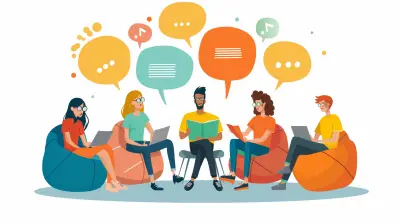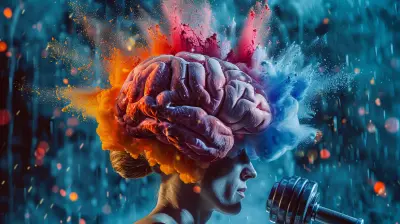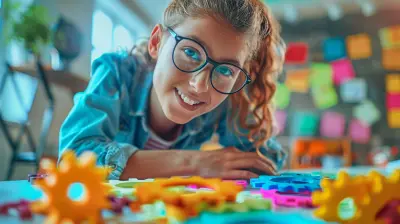How to Create a Media-Literate Classroom
30 January 2025
In today's world, media is everywhere. Whether it's news, social media, television, or advertisements, we are constantly bombarded with information from all directions. While this presents a wealth of opportunities, it also raises a key question: How do we make sense of it all? More importantly, how do we teach the next generation to navigate this complex media landscape? That’s where media literacy comes in. Creating a media-literate classroom is crucial for developing critical thinking skills in students, helping them to not just consume media, but to understand, analyze, and critique it.
But how exactly do you create a media-literate classroom? If you’re asking yourself this question, you’re in the right place! Let’s dive deep into what media literacy is, why it’s important, and most importantly, how you can foster it in your classroom.

What is Media Literacy?
Before we jump into the how, let’s first tackle the what. Media literacy refers to the ability to access, analyze, evaluate, and create media in various forms. It’s not just about understanding the content but also recognizing the intent behind it. Who created this? What’s their goal? What techniques are they using to influence the audience?Being media-literate means being able to ask critical questions about the media you consume. It’s about seeing beyond the surface and understanding the deeper messages, biases, and influences at play. In a world dominated by digital content, teaching media literacy helps students become smarter, more responsible consumers and creators of information.

Why is Media Literacy Important?
In the age of fake news, deepfakes, and viral misinformation, media literacy is more important than ever. Children and teens today are growing up in an environment where information is more accessible than ever before—but not all of it is trustworthy.Without proper guidance, they may not be able to differentiate between credible sources and unreliable ones, making them more susceptible to manipulation. Media literacy equips students with the tools they need to question what they see and hear, helping them make informed decisions and opinions.
Moreover, media literacy isn’t just about avoiding misinformation. It’s also about fostering creativity and encouraging students to think critically about the media they create and share. By understanding the power and influence of media, students can become more thoughtful communicators.
The Role of Educators in Media Literacy
As educators, the responsibility of equipping students with media literacy skills falls squarely on our shoulders. But don’t worry—it’s not as daunting as it sounds. You don’t need to be a media expert to teach media literacy. What you do need is a willingness to incorporate critical thinking and analysis into your lessons and encourage students to be curious and skeptical.A media-literate classroom isn’t built overnight, but with some strategic approaches, you can make it an integral part of your teaching. Let’s explore how to do that.

How to Create a Media-Literate Classroom
1. Start with Critical Thinking
At the heart of media literacy is critical thinking. To help students become media-literate, you need to first teach them how to think critically about the information they consume. Encourage them to ask questions like:- Who created this message?
- What is the purpose of this message?
- Who is the target audience?
- What techniques are being used to attract my attention?
- What might be omitted from this message?
These questions prompt students to look beyond the surface and consider the deeper context of the media they’re engaging with. Incorporate these questions into your lessons, whether you’re analyzing a news article, a video, or even a social media post.
2. Integrate Media Literacy into Your Curriculum
The beauty of media literacy is that it can be woven into almost any subject. Whether you’re teaching history, science, English, or social studies, there’s always an opportunity to incorporate media analysis.For example, if you’re teaching history, you can have students analyze newspaper articles or propaganda posters from a particular period. In an English class, students can critique the portrayal of characters in movies or books. In science, students can evaluate how scientific discoveries are represented in the media.
By integrating media literacy into different subjects, you make it a seamless part of the learning experience, rather than a standalone topic.
3. Use Real-World Examples
One of the best ways to teach media literacy is by using current, real-world examples. Media is constantly evolving, and using examples that are relevant to students’ lives will help them engage with the material.For instance, you can analyze advertisements, news headlines, or viral social media posts that are trending at the moment. You can also look at how different news outlets report on the same event and discuss the differences in tone, language, and emphasis.
By using real-world examples, you not only make the lessons more engaging but also show students how media literacy applies to their everyday lives.
4. Teach Students How to Fact-Check
One of the most important skills a media-literate individual can have is the ability to fact-check. In a world where misinformation spreads like wildfire, knowing how to verify information is critical.Introduce students to reliable fact-checking websites like Snopes, FactCheck.org, or PolitiFact. Teach them how to cross-reference information and look for primary sources. Encourage them to question the credibility of a source before accepting it as truth.
Fact-checking can be turned into a fun and engaging activity. For example, you can present students with a piece of news and have them work in groups to verify its accuracy. This not only teaches them how to fact-check but also fosters collaboration and discussion.
5. Encourage Media Creation
Media literacy isn’t just about analyzing media—it’s also about creating it. Encourage students to become media creators themselves. Whether it’s writing a blog, creating a podcast, or producing a short video, hands-on activities allow students to put their media literacy skills into practice.By creating media, students gain a better understanding of how messages are crafted and how different techniques can be used to influence an audience. They also learn about the ethical responsibilities that come with being a content creator.
You can even set up a class blog or YouTube channel where students can showcase their work. This not only gives them a sense of ownership but also allows them to engage with a wider audience.
6. Discuss Bias and Representation
No media message is completely neutral. Every piece of media is created by someone with a particular perspective, and that perspective can influence how information is presented. In your classroom, it’s important to discuss bias and representation in media.For example, you can examine how different groups of people are represented in movies, TV shows, or advertisements. Are certain stereotypes being reinforced? Are certain voices being excluded or marginalized? By discussing these issues, you help students develop an awareness of how media can shape our understanding of the world.
7. Foster a Safe Space for Discussion
Media literacy involves exploring complex and sometimes controversial topics. It’s essential to create a classroom environment where students feel safe sharing their thoughts and opinions. Encourage open dialogue and active listening. Make it clear that all viewpoints are welcome, as long as they are respectful.By fostering a safe space for discussion, you empower students to express their ideas and engage in meaningful conversations about media. This not only enhances their critical thinking skills but also helps them learn how to navigate differing opinions in a constructive way.
8. Stay Updated on Emerging Media Trends
The media landscape is constantly changing. New platforms, tools, and trends are emerging all the time. As an educator, it’s important to stay updated on these changes so you can incorporate them into your teaching.For example, the rise of TikTok has introduced new forms of media communication, such as short-form videos. Streaming services have changed the way we consume television and movies. By staying informed about these trends, you can ensure that your lessons remain relevant and engaging for your students.

Conclusion
Creating a media-literate classroom is no longer an option; it’s a necessity. In a world where media is omnipresent, students need the skills to critically evaluate the information they consume and create. By fostering critical thinking, integrating real-world examples, teaching fact-checking skills, and encouraging media creation, you can help your students become savvy, responsible media consumers and creators.Remember, media literacy isn’t about shielding students from the media; it’s about empowering them to navigate it with confidence. And the best part? You don’t have to be a media expert to teach these skills. All it takes is a commitment to fostering curiosity, critical thinking, and open dialogue in your classroom.
So, are you ready to create a media-literate classroom?
all images in this post were generated using AI tools
Category:
Media LiteracyAuthor:

Madeleine Newton
Discussion
rate this article
17 comments
Serenity Huffman
Creating a media-literate classroom is like teaching kids to swim—first, you splash around, then you float! Just remember, no one likes a lifeguard who forgets to check the snacks!
February 18, 2025 at 5:26 AM

Madeleine Newton
Absolutely! Just like swimming, media literacy involves practice and support, but don’t forget to keep it engaging and fun—snacks included!
Caleb McCullough
This article beautifully highlights the importance of media literacy; equipping our students is essential for their future. Thank you!
February 17, 2025 at 9:17 PM

Madeleine Newton
Thank you for your kind words! I'm glad you found the article valuable for fostering media literacy in our students.
Giovanna Rios
This article effectively highlights essential strategies for fostering media literacy among students. Emphasizing critical thinking and diverse perspectives is crucial in today's information-rich environment. Practical tips and real-world examples could further enhance engagement and application in the classroom. Great insights!
February 16, 2025 at 5:40 AM

Madeleine Newton
Thank you for your insightful feedback! I appreciate your suggestions on incorporating practical tips and real-world examples to enhance student engagement in media literacy.
Rook Cooper
Great insights! Fostering media literacy equips students with essential skills for critical thinking, empowering them to navigate today’s information-rich world confidently.
February 15, 2025 at 11:55 AM

Madeleine Newton
Thank you! I'm glad you found the insights valuable. Media literacy is indeed crucial for empowering students in today's information landscape.
Jane McKellar
Great insights! Fostering media literacy is essential in today's digital landscape. Consider incorporating hands-on activities and real-world examples to engage students further. Developing critical thinking skills will empower them to navigate media effectively.
February 14, 2025 at 7:53 PM

Madeleine Newton
Thank you for your thoughtful feedback! I completely agree that hands-on activities and real-world examples are vital for enhancing media literacy and critical thinking skills in the classroom.
Bria Willis
Empower students to critically analyze media for better understanding and engagement.
February 12, 2025 at 12:24 PM

Madeleine Newton
Absolutely! Empowering students to critically analyze media fosters deeper understanding and enhances their engagement with content, making them more informed citizens.
Zachary Ramos
Creating a media-literate classroom is essential in today's information age. Educators should incorporate critical thinking, diverse sources, and analytical discussions to empower students to navigate media responsibly and discern credible information effectively.
February 11, 2025 at 1:27 PM

Madeleine Newton
Absolutely! Empowering students through critical thinking and diverse sources is key to fostering media literacy in the classroom. Thank you for highlighting this essential approach!
Holly Thornton
Creating a media-literate classroom involves integrating critical thinking skills, fostering discussions about media sources, and encouraging students to analyze various forms of media. Teachers should provide diverse resources, engage students in hands-on projects, and promote a culture of inquiry to empower learners in navigating today's complex media landscape.
February 9, 2025 at 8:39 PM

Madeleine Newton
Thank you for your insightful comment! I completely agree—integrating critical thinking and diverse resources is essential for fostering media literacy in the classroom.
Quade Davis
Creating a media-literate classroom is like teaching kids to navigate a buffet—help them choose the good stuff while avoiding the junk. Just remember, not all 'desserts' on the internet are sweet! 🍰📚
February 5, 2025 at 9:57 PM

Madeleine Newton
Absolutely! Just like a buffet, guiding students to critically assess and select quality information is essential for building their media literacy skills. 🍽️✨
Lysara Vance
Empower students with critical thinking skills for effective media evaluation.
February 3, 2025 at 12:22 PM

Madeleine Newton
Absolutely! Fostering critical thinking skills is essential for students to navigate and evaluate media effectively. It equips them to discern credible sources and make informed decisions.
Thorne McKellar
Creating a media-literate classroom is essential for empowering students. Your insights on fostering critical thinking and responsible consumption of information resonate deeply. Thank you for shedding light on this important topic!
February 2, 2025 at 3:26 AM

Madeleine Newton
Thank you for your kind words! I'm glad to hear the topic resonates with you, and I appreciate your support for fostering media literacy in education.
Paul McLean
Empower students to critically analyze media; it's essential for informed citizenship and lifelong learning.
February 1, 2025 at 7:22 PM

Madeleine Newton
Absolutely! Encouraging critical media analysis equips students with essential skills for navigating information and making informed decisions throughout their lives.
Bryce McAlister
In an age inundated with information, fostering media literacy is essential. By empowering students to critically analyze sources, discern bias, and understand the implications of media choices, educators not only enhance academic skills but also encourage informed citizenship. A media-literate classroom cultivates thoughtful consumers of information in a complex digital landscape.
February 1, 2025 at 12:37 PM

Madeleine Newton
Absolutely! Media literacy is vital for navigating today’s information overload. Educators play a crucial role in empowering students to critically engage with media, fostering essential skills for both academic success and informed citizenship.
Caelum Kirkpatrick
This article emphasizes the importance of fostering critical thinking skills in students. By prioritizing media literacy, we empower them to navigate today’s complex information landscape.
January 31, 2025 at 9:19 PM

Madeleine Newton
Thank you for your feedback! Critical thinking and media literacy are indeed crucial for students to thrive in today's information age. I'm glad the article resonated with you!
Tracie McCloud
Excited to explore innovative strategies for fostering media literacy in today's diverse classrooms!
January 31, 2025 at 4:14 AM

Madeleine Newton
Thank you! I'm excited to hear your enthusiasm for promoting media literacy in diverse classrooms. Together, we can empower students to navigate the complex media landscape!
Kyle Carr
Empower students to critically engage with media—shape informed, thoughtful, and responsible future leaders!
January 30, 2025 at 9:53 PM

Madeleine Newton
Absolutely! Empowering students to critically engage with media is essential for fostering informed and responsible future leaders. Let's inspire thoughtful media consumption!
Kylie Gomez
To foster media literacy effectively, educators should integrate critical thinking exercises, diverse media sources, and discussions on misinformation, ensuring students can navigate information responsibly and thoughtfully.
January 30, 2025 at 5:15 AM

Madeleine Newton
Thank you for your insightful comment! Integrating critical thinking and diverse sources is indeed essential for fostering media literacy in the classroom.
MORE POSTS

How Peer Feedback Helps Students Master Complex Concepts

How to Create an Effective Study Schedule for Online Courses

The Role of Educational Research in Shaping Classroom Practices

The Connection Between Physical Exercise and Cognitive Performance

Strategies for Academic Success in Higher Education

How to Integrate Peer Feedback into Formative Assessments

The Connection Between Math and Music: A Harmonious Relationship

How to Excel in Distance Education Without Sacrificing Personal Time

How to Introduce Algebra to Young Learners

Creating Safe and Nurturing Spaces for Early Learners

How to Use Project-Based Learning for Real-World Skill Application